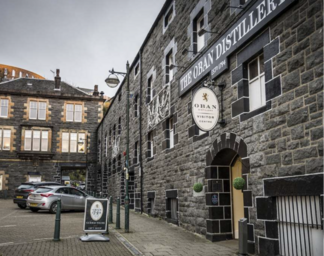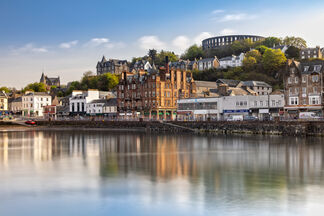Oban Distillery
What Came First - The Town or The Distillery?
For starters, it’s pronounced OH-bin. Oban is a fairly isolated distillery, perched on the westernedge of the Scottish mainland at the very top of the Kintyre peninsula. Established in 1794, the distillery is one of the oldest still active in Scotland. It is one of very few remaining urban distilleries. But it has not always been an urban distillery! It was built as a brewery in 1790 to serve the local fishing hamlet. Located only 208 steps from the sea.
The town grew up around the brewery, which in 1794 evolved into a distillery producing whisky. It is now right on the Main Street in the centre of Oban. It has never been moved.
A Bit About Oban
Oban is the frontier between the West Highlands and the Islands; the meeting place between land and sea. A perfect, sheltered harbour makes it the principal seaport for the Isles and the capital of the West Highlands. It has a mild, temperate climate, warmed by the Gulf Stream and washed (too often, some might say) by the soft rain that often falls hereabouts. This misty, briny character, with a background of heather and peat, is perfectly echoed in the malt whisky produced at Oban.
Above the town stands McCaig's Tower (also known as McCaig's Folly). It is built of Bonawe granite, has a circumference of about 200 metres. It is a Grade B Listed historic monument. The structure was commissioned, at a cost of £5,000 sterling (worth around 1M€ today) by the wealthy, philanthropic banker (North of Scotland Bank), John Stuart McCaig. The tower was erected between 1897 and his death, aged 78 from cardiac arrest, on 29 June 1902. At that point, construction stopped. I wonder if he had a cardiac arrest when he saw the cost!
McCaig's intention was to provide a lasting monument to his family, and provide work for the local stonemasons during the winter months. His death brought an end to construction, with only the outer walls completed. Although his will included £1,000 per year for maintenance, the will was disputed by his heirs andtheir appeal to the court was successful.
The Founding Family: The Stevensons
The distillery's founders, John and Hugh Stevenson and their family read like they were the local wide boys as well as being entrepreneurs and pioneers! John and Hugh owned and operated several businesses in the area and developed the local fishing hamlet. They were local men - their mother had come from Port Appin upon the death of their father, a stone mason. Both learned the stonemason's craft. Hugh opened a shop selling whisky and later took over slate quarries. His brother became a farmer, architect and builder. Together they established a boat building yard, a tannery and then the brewery which became Oban Distillery in 1794.
Two further generations of Stevensons continued the family's business interests in Oban. Hugh's son, Thomas, who had been farming in Buenos Aires, returned and purchased the distillery and the slate quarries from his father and uncle's trustees. Later he built the Caledonian Hotel, but, alas, he ran into financial difficulties through supporting his brother in a printing business in Edinburgh. He attempted to satisfy his creditors by supplying them with slates and whisky.
Thomas’ son, John, who had been living in Peru, but who returned and took over the running of the distillery in 1830, helped Thomas. He managed Oban until shortly before his death in 1869, when it finally passed out of the family.
Post Stevenson Ownership
In 1883 J. Walter Higgin bought the distillery. Between 1890 and 1894 he dismantled and rebuilt it bit by bit, in order to keep it in production - such was the demand for Oban's malt. He carefully replicated the famously small stills and other traditional features in order to preserve the quality of the whisky. During the refurbishment in the 1890's, a remnant of Oban Bay's ancient beginnings was revealed when a cave (which has now been resealed) containing Mesolithic human remains was discovered behind the distillery.
Distillery owners and managers to the present day have embraced this tradition of community involvement and hospitality - a tradition that came naturally to John and Hugh Stevenson, founders not only of the distillery at Oban but of the town itself.
Oban Whisky Today
Oban is now owned by Diageo. It was sold to DCL in 1930 who eventually folded up into Diageo. It is the second second-smallest in their ownership after Royal Lochnagar. Oban produces less than 0.7 million litres per year. The water flows in from a loch three miles away. The malted barley travels from Speyside.
The standard expression is the 14 year-old, which has been the Western Highland representative of Diageo's Classic Malt series since their inception in 1987. The other core bottling is a vintage Distiller's Edition finished in Montilla Fino casks (generally regarded as one of the more successful Distiller's Editions). There have also been a brace of cask-strength aged expressions released as part of Diageo's Special Releases: a 1969 vintage 32 year-old released in 2002 was followed by a 1984 vintage 20yo in 2004. Independent bottlings, as with most of Diageo's distileries, are extremely rare. They just will not sell casks to independent bottlers.
Taste style: Medium. Quite malty and sweet opening, with a medium body and a generous dry finish. A hint of spiciness perhaps, and seashore on the nose.
The core 14 year old Oban costs around 70€.

